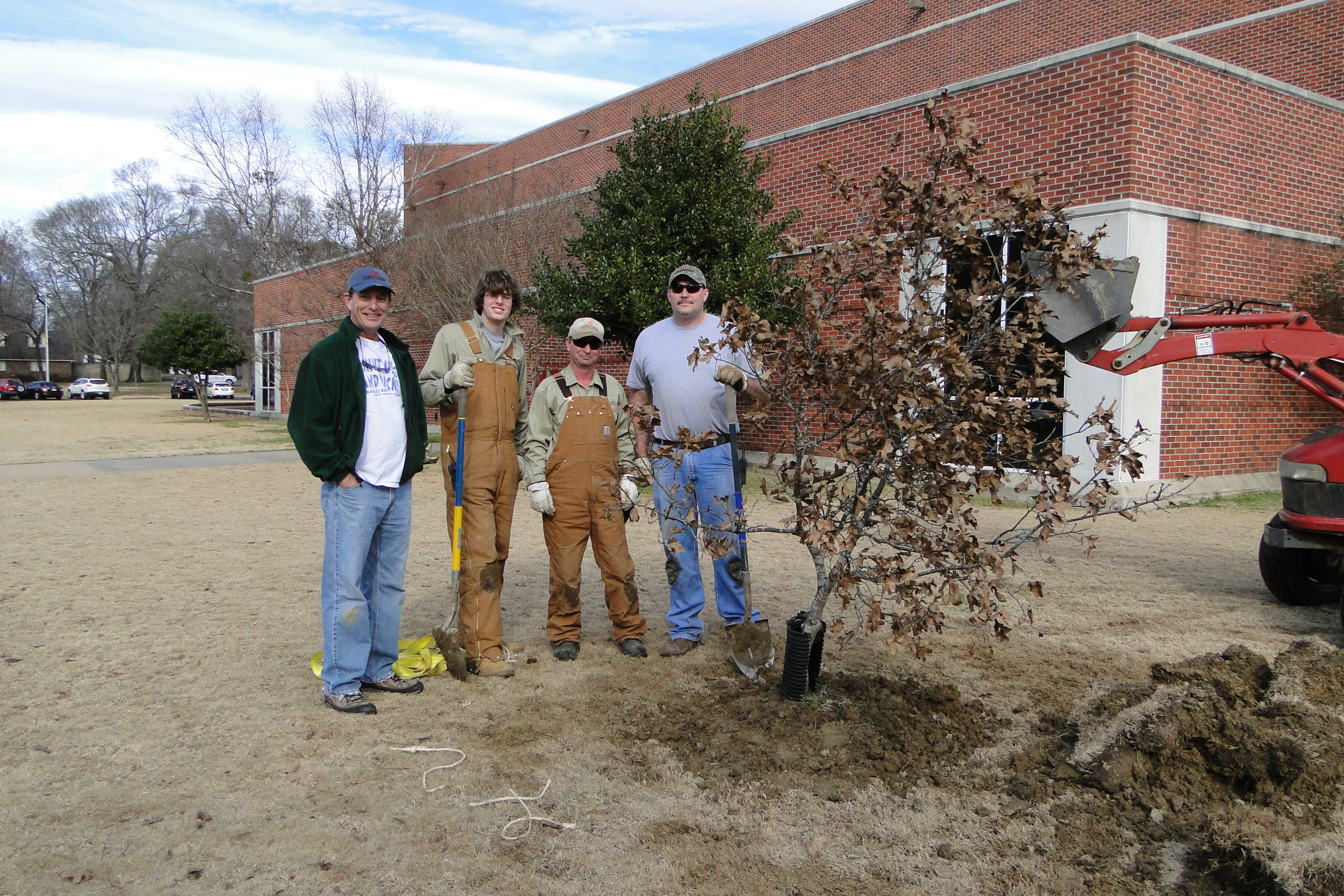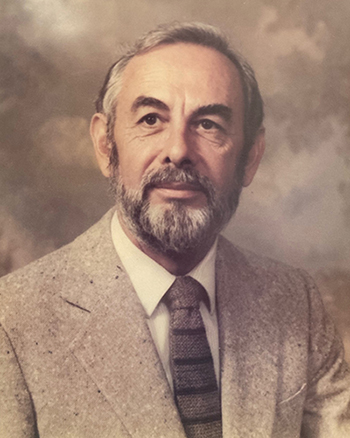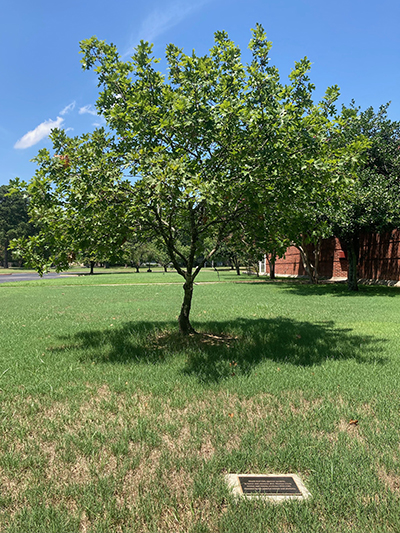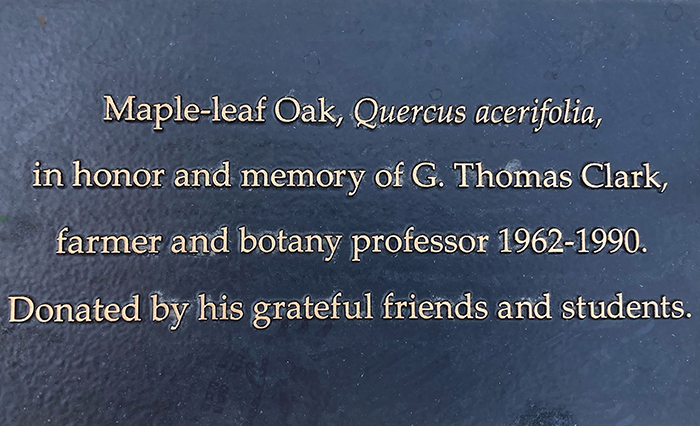Years-long
labor of love brought rare memorial tree to campus

This photo was taken in January 2012, when the
maple-leaf oak grown in memory of Professor G. Thomas Clark arrived on campus. Pictured,
from left: Ples Spradley ’79, Hendrix Grounds staff members Eric Plemmons,
Daryl Schaefers, and Chad Collins. / Photo courtesy Hendrix
Facilities Maintenance
CONWAY, Arkansas (August 8, 2022)—Sturdy trees take time to grow,
but the benefit of their presence makes up for the wait. One specimen in the
Hendrix College campus arboretum illustrates that value both ecologically and
as a fitting tribute to a revered Hendrix College professor.
The rare maple-leaf
oak,
situated near Bailey Library for the past decade, may register to most
passersby simply as one more beautiful tree among thousands. But this tree, one
of Dr. G. Thomas Clark’s favorite species, differs from the many other memorial
trees on campus because before the acorn was even planted, its purpose as a
tribute to him was set.
 Clark taught at Hendrix from 1962 until his death in 1990,
and for the last decade of his life held the C. Louis and Charlotte Cabe
Distinguished Professorship of Biology. During his tenure at Hendrix, he
inspired untold numbers of students, three of whom helped create this living
memorial to their mentor.
Clark taught at Hendrix from 1962 until his death in 1990,
and for the last decade of his life held the C. Louis and Charlotte Cabe
Distinguished Professorship of Biology. During his tenure at Hendrix, he
inspired untold numbers of students, three of whom helped create this living
memorial to their mentor.
Making it happen
The tree graces the campus today thanks to an effort led by Dr.
Clark’s former students Joe Waldrum ’68 and Ples Spradley ’79, both plant
specialists with the University of Arkansas Extension Service (though Waldrum has
since retired).
Waldrum, who served as a teaching assistant to Professor
Clark during his undergraduate years, remembers his mentor leading botany
students on campus tours of native trees.
“Somewhere in the process he said, ‘There’s one native tree I
can’t show you,’” Waldrum said. That species was the maple-leaf oak, and as far
as Clark knew at the time, it grew nowhere except Mount Magazine, the state’s
highest peak.
That piece of information, along with memories of a field
trip Spradley had once taken with Clark to see the rare trees, stayed with both
alumni across the years. It turned into action in the early part of the 21st
century, when David Blackburn, a friend of Spradley’s who worked for the
Arkansas State Plant Board, helped the duo find their way to some of the maple-leaf
oaks on the mountain. “We just started looking for these trees and started
collecting acorns,” Waldrum said. “We split them between the three of us.”
All three men planted some acorns and kept each other posted
on their progress. “The only one that had any luck was Ples,” Waldrum said.
Spradley and his wife had a farm in the northern part of the state, which he
concluded would work better than his yard in Little Rock for getting the seedlings
to take root.
When his seedlings had grown into established trees up on the
farm, Spradley worked with experts from a tree farm to identify the one best
suited to make the trip to Hendrix and most likely to stay healthy following
the move. In January 2012, he coordinated with Nate Cowden, the College’s
director of operations for grounds, to have the tree transported to campus and
planted in memory of the biology professor who helped shape Spradley’s own
career, Waldrum’s, and so many others.
“We wanted a place with full sun, because they do best with
that,” Spradley said. Cowden, who formerly worked for the State Plant Board,
recommended the spot near Bailey Library where the tree now flourishes.
 In the fall of 2021, a plaque memorializing Dr. Clark took
its place at the base of the maple-leaf oak.
In the fall of 2021, a plaque memorializing Dr. Clark took
its place at the base of the maple-leaf oak.
Beth Phelps ’80, who had been one of Clark’s students when
Spradley served as his teaching assistant, teamed up with Spradley and Waldrum to
help finalize the gift of the plaque. They worked with another trio—Clark’s
children, all of whom are wordsmiths, including 2019 Hendrix Odyssey Medal
recipient Patterson “Patt” Clark ’77 (whose website Alienweeds displays some of his talent at
the intersection of words, art, and plant life).
Dr. Thomas Clark “was the greatest professor I ever had, and
now I’m friends with all his kids,” Spradley said.
Professor Clark’s descendants are delighted with the memorial
to their father.
“The tree is a most fitting legacy to the things he held
dear: the land, the plants, and continuum,” said Nancy Lewis, adding that she
and her siblings, Patt Clark and Holly Coburn, are grateful to Spradley,
Waldrum, and Phelps for their efforts, and for the guidance of Melissa Jenkins,
who worked as a gifts officer for the College at the time the memorial plaque
was placed.
Clark’s children recall that during the last year of his
life, their dad told them that he wanted to be remembered as a farmer. In
accordance with that wish, the plaque identifies him as “farmer and botany
professor.”
“In the 1950s, he managed the family farm in Illinois,
helping raise hogs, sheep, dairy cattle, corn, wheat, soybeans, Christmas
trees, bottomland timber, and four children,” said Patt Clark.
In the early 1960s he arrived at Hendrix, where he nurtured
two generations of budding botanists and plant ecologists, cultivated
environmental awareness, and helped transform the campus into an arboretum of
trees native to Arkansas.
For the next 30 years, in addition to teaching and parenting,
“he maintained a large vegetable garden, where he experimented with organic
gardening techniques and was always delighted to share his wisdom and his
produce,” Coburn said.
Strong tree honoring a strong mentor
The Spradleys sold their farmland in 2019, but not before Ples
explained the significance of the remaining maple-leaf oaks to the property’s
new owner. “One of them is going to end up being the champion maple-leaf oak in
the state, or the world,” he said. “It just took off.” He doesn’t need access
to those trees, though, with the one at Hendrix so close by. He returned to campus
last fall and collected some of its acorns, put them in peat moss, and
refrigerated them for several months; he has four more seedlings now. And he
plans to visit Hendrix again this fall to gather more acorns to send to Patt Clark,
who lives in Washington D.C.
As for the campus tree, it has done nothing but thrive.
“It’s pretty hardy,” Waldrum said. “It has to be, to live up
on Mount Magazine.”
“It’s the stoutest [species of] tree I’ve ever dealt with,”
said Spradley.
The duo recalled Professor Clark as fit—so fit that it was
sometimes a challenge for students to keep up to his pace on field trips—and
soft spoken, which was another reason students needed to try to keep up: so they
could hear the knowledge he was sharing. Waldrum remembered his mentor as both
a gentleman and a gentle man.
Concerning the years it took to bring the memorial to
fruition, Waldrum’s reflection resonates with the deep roots left by the life’s
work of his mentor:
“It was a long process,” he said, “but if you want something
to last, it’s probably going to take a while to do it.”

About Hendrix College
A private liberal arts
college in Conway, Arkansas, Hendrix College consistently earns recognition as
one of the country’s leading liberal arts institutions, and is featured in
Colleges That Change Lives: 40 Schools That Will Change the Way You Think About
Colleges. Its academic quality and rigor, innovation, and value have
established Hendrix as a fixture in numerous college guides, lists, and
rankings. Founded in 1876, Hendrix has been affiliated with the United
Methodist Church since 1884. To learn more, visit www.hendrix.edu.